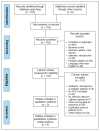Infectious Complications in Home Parenteral Nutrition: A Systematic Review and Meta-Analysis Comparing Peripherally-Inserted Central Catheters with Other Central Catheters
- PMID: 31487777
- PMCID: PMC6770172
- DOI: 10.3390/nu11092083
Infectious Complications in Home Parenteral Nutrition: A Systematic Review and Meta-Analysis Comparing Peripherally-Inserted Central Catheters with Other Central Catheters
Abstract
Background: Home parenteral nutrition (HPN) has become a common therapy. There is still controversy regarding the possibility that peripherally inserted central catheters (PICCs) may diminish catheter-related blood stream infection (CRBSI) rates.
Methods: We searched the PubMed database for studies reporting the rates of CRBSI with HPN. Study selection was performed independently by three investigators. Disagreements were discussed and resolved by consensus or by arbitration by an author not involved in the search. The National Institutes of Health Quality Assessment Tools was used to assess the methodological quality of the studies. Meta-analyses were performed using MetaXL 5.3 with the quality effects model.
Results: Screening of the article titles and abstracts yielded 134 full text articles for evaluation. Only three prospective studies that included appropriate data were considered for the final analysis. The relative risk of the CRBSI rate was 0.41 (0.14-1.17) for PICC vs. tunneled catheters. The relative risk of the CRBSI rate was 0.16 (0.04-0.64) for PICC vs. ports. The relative risk of the thrombosis rate was 3.16 (0.20-49.67) for PICCs vs. tunneled.
Conclusions: There is insufficient evidence to show a difference in CRBSI rates between PICCs and tunneled catheters. On the other hand, PICCs showed lower CRBSI rates than ports. There was also no difference in the rate of catheter-related thrombosis and mechanical complications.
Keywords: catheter-related infection; central catheter; home parenteral nutrition; peripherally inserted central catheter; port; tunneled catheter.
Conflict of interest statement
The Authors declare no conflict of interest for the present study.
Figures





Similar articles
-
Rate of Catheter-Related Bloodstream Infections Between Tunneled Central Venous Catheters Versus Peripherally Inserted Central Catheters in Adult Home Parenteral Nutrition: A Meta-analysis.JPEN J Parenter Enteral Nutr. 2019 Jan;43(1):41-53. doi: 10.1002/jpen.1421. Epub 2018 Jul 23. JPEN J Parenter Enteral Nutr. 2019. PMID: 30035806
-
Infectious complications in home parenteral nutrition: A long-term study with peripherally inserted central catheters, tunneled catheters, and ports.Nutrition. 2019 Feb;58:89-93. doi: 10.1016/j.nut.2018.06.016. Epub 2018 Jul 11. Nutrition. 2019. PMID: 30391696
-
Comparison of complications associated with peripherally inserted central catheters and Hickman™ catheters in patients with intestinal failure receiving home parenteral nutrition. Six-year follow up study.Clin Nutr. 2016 Aug;35(4):912-7. doi: 10.1016/j.clnu.2015.06.009. Epub 2015 Jul 28. Clin Nutr. 2016. PMID: 26269383
-
Comparative Complication Rates of 854 Central Venous Access Devices for Home Parenteral Nutrition in Cancer Patients: A Prospective Study of Over 169,000 Catheter-Days.JPEN J Parenter Enteral Nutr. 2021 May;45(4):768-776. doi: 10.1002/jpen.1939. Epub 2020 Jul 4. JPEN J Parenter Enteral Nutr. 2021. PMID: 32511768
-
To Pull or Not to Pull: Salvaging Central Line Catheters in Home Parenteral Nutrition.Curr Nutr Rep. 2018 Dec;7(4):324-328. doi: 10.1007/s13668-018-0245-y. Curr Nutr Rep. 2018. PMID: 30264353 Review.
Cited by
-
Ready-to-Use Multichamber Bags in Home Parenteral Nutrition for Patients with Advanced Cancer: A Single-Center Prospective Study.Nutrients. 2024 Feb 5;16(3):457. doi: 10.3390/nu16030457. Nutrients. 2024. PMID: 38337741 Free PMC article.
-
Glucagon-like peptide-2 analogues for Crohn's disease patients with short bowel syndrome and intestinal failure.World J Gastroenterol. 2022 Nov 28;28(44):6258-6270. doi: 10.3748/wjg.v28.i44.6258. World J Gastroenterol. 2022. PMID: 36504557 Free PMC article. Review.
-
Evidence summary of prevention strategies for catheter-related infections among cancer patients with home parenteral nutrition.Asia Pac J Oncol Nurs. 2024 Aug 10;11(10):100570. doi: 10.1016/j.apjon.2024.100570. eCollection 2024 Oct. Asia Pac J Oncol Nurs. 2024. PMID: 39290826 Free PMC article. Review.
-
Analysis of risk factors of PICC-related bloodstream infection in newborns: implications for nursing care.Eur J Med Res. 2021 Jul 23;26(1):80. doi: 10.1186/s40001-021-00546-2. Eur J Med Res. 2021. PMID: 34301331 Free PMC article.
-
Is YouTube™ a useful source of information on home parenteral nutrition?BMC Public Health. 2025 Feb 19;25(1):684. doi: 10.1186/s12889-025-21929-8. BMC Public Health. 2025. PMID: 39972296 Free PMC article.
References
-
- Wanden-Berghe Lozano C., Cunill J.L.P., Compes C.C., Boluda E.R., Jimenez M.I.M., Candela C.G., Casas N.V., Pelaez R.B., de la Cruz A.P., Lazaro M.F.P., et al. [Home and Ambulatory Artificial Nutrition (Nadya) Report. Home Parenteral Nutrition in Spain, 2017] Nutr. Hosp. 2018;35:1491–1496. doi: 10.20960/nh.2364. - DOI - PubMed
-
- Hortencio T.D., Arendt B.M., Teterina A., Jeejeebhoy K.N., Gramlich L.M., Whittaker J.S., Armstrong D., Raman M., Nogueira R.J., Allard J.P. Changes in Home Parenteral Nutrition Practice Based on the Canadian Home Parenteral Nutrition Patient Registry. JPEN J. Parenter. Enteral Nutr. 2017;41:830–836. doi: 10.1177/0148607115609289. - DOI - PubMed
-
- Winkler M.F., DiMaria-Ghalili R.A., Guenter P., Resnick H.E., Robinson L., Lyman B., Ireton-Jones C., Banchik L.H., Steiger E. Characteristics of a Cohort of Home Parenteral Nutrition Patients at the Time of Enrollment in the Sustain Registry. JPEN J. Parenter. Enteral Nutr. 2016;40:1140–1149. doi: 10.1177/0148607115586575. - DOI - PubMed
-
- Farmer D.G., Venick R.S., Colangelo J., Esmailian Y., Yersiz H., Duffy J.P., Cortina G.R., Artavia K., Ngo K., McDiarmid S.V., et al. Pretransplant Predictors of Survival after Intestinal Transplantation: Analysis of a Single-Center Experience of More Than 100 Transplants. Transplantation. 2010;90:1574–1580. doi: 10.1097/TP.0b013e31820000a1. - DOI - PubMed
-
- Wanden-Berghe C., Nolasco A., Planas M., Sanz-Valero J., Rodriguez T., Cuerda C., Guardiola R., Castello-Botia I. Health-Related Quality of Life According to the Main Caregiver in Patients with Home Nutritional Support. Med. Clin. (Barc) 2008;131:281–284. doi: 10.1016/S0025-7753(08)72258-9. - DOI - PubMed
Publication types
MeSH terms
LinkOut - more resources
Full Text Sources
Medical

